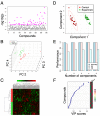Systematic applications of metabolomics in metabolic engineering
- PMID: 24957776
- PMCID: PMC3901235
- DOI: 10.3390/metabo2041090
Systematic applications of metabolomics in metabolic engineering
Abstract
The goals of metabolic engineering are well-served by the biological information provided by metabolomics: information on how the cell is currently using its biochemical resources is perhaps one of the best ways to inform strategies to engineer a cell to produce a target compound. Using the analysis of extracellular or intracellular levels of the target compound (or a few closely related molecules) to drive metabolic engineering is quite common. However, there is surprisingly little systematic use of metabolomics datasets, which simultaneously measure hundreds of metabolites rather than just a few, for that same purpose. Here, we review the most common systematic approaches to integrating metabolite data with metabolic engineering, with emphasis on existing efforts to use whole-metabolome datasets. We then review some of the most common approaches for computational modeling of cell-wide metabolism, including constraint-based models, and discuss current computational approaches that explicitly use metabolomics data. We conclude with discussion of the broader potential of computational approaches that systematically use metabolomics data to drive metabolic engineering.
Figures


Similar articles
-
Metabolomics and modelling approaches for systems metabolic engineering.Metab Eng Commun. 2022 Oct 15;15:e00209. doi: 10.1016/j.mec.2022.e00209. eCollection 2022 Dec. Metab Eng Commun. 2022. PMID: 36281261 Free PMC article. Review.
-
Flux analysis and metabolomics for systematic metabolic engineering of microorganisms.Biotechnol Adv. 2013 Nov;31(6):818-26. doi: 10.1016/j.biotechadv.2013.05.002. Epub 2013 May 13. Biotechnol Adv. 2013. PMID: 23680193 Review.
-
Genome-Scale 13C Fluxomics Modeling for Metabolic Engineering of Saccharomyces cerevisiae.Methods Mol Biol. 2019;1859:317-345. doi: 10.1007/978-1-4939-8757-3_19. Methods Mol Biol. 2019. PMID: 30421239
-
Integration of metabolomics data into metabolic networks.Front Plant Sci. 2015 Feb 17;6:49. doi: 10.3389/fpls.2015.00049. eCollection 2015. Front Plant Sci. 2015. PMID: 25741348 Free PMC article. Review.
-
Applications of stable isotope-based metabolomics and fluxomics toward synthetic biology of cyanobacteria.Wiley Interdiscip Rev Syst Biol Med. 2020 May;12(3):e1472. doi: 10.1002/wsbm.1472. Epub 2019 Dec 9. Wiley Interdiscip Rev Syst Biol Med. 2020. PMID: 31816180 Review.
Cited by
-
Metabolomics, Standards, and Metabolic Modeling for Synthetic Biology in Plants.Front Bioeng Biotechnol. 2015 Oct 21;3:167. doi: 10.3389/fbioe.2015.00167. eCollection 2015. Front Bioeng Biotechnol. 2015. PMID: 26557642 Free PMC article. Review.
-
MINEs: open access databases of computationally predicted enzyme promiscuity products for untargeted metabolomics.J Cheminform. 2015 Aug 28;7:44. doi: 10.1186/s13321-015-0087-1. eCollection 2015. J Cheminform. 2015. PMID: 26322134 Free PMC article.
-
Metabolomics Analysis of the Toxic Effects of the Production of Lycopene and Its Precursors.Front Microbiol. 2018 May 3;9:760. doi: 10.3389/fmicb.2018.00760. eCollection 2018. Front Microbiol. 2018. PMID: 29774011 Free PMC article.
-
NS-kNN: a modified k-nearest neighbors approach for imputing metabolomics data.Metabolomics. 2018 Nov 23;14(12):153. doi: 10.1007/s11306-018-1451-8. Metabolomics. 2018. PMID: 30830437 Free PMC article.
-
Biomarker enrichment medium: A defined medium for metabolomic analysis of microbial pathogens.Front Microbiol. 2022 Jul 22;13:957158. doi: 10.3389/fmicb.2022.957158. eCollection 2022. Front Microbiol. 2022. PMID: 35935218 Free PMC article.
References
-
- Zaldivar J.Z., Borges A.B., Johansson B.J., Smits H.S., Villas-Bôas S.V.-B., Nielsen J.N., Olsson L.O. Fermentation performance and intracellular metabolite patterns in laboratory and industrial xylose-fermenting Saccharomyces cerevisiae. Appl. Microbiol. Biot. 2002;59:436–442. doi: 10.1007/s00253-002-1056-y. - DOI - PubMed
-
- Sonderegger M., Jeppsson M., Hahn-Hägerdal B., Sauer U. Molecular Basis for Anaerobic Growth of Saccharomyces cerevisiae on Xylose, Investigated by Global Gene Expression and Metabolic Flux Analysis. Appl. Environ. Microb. 2004;70:2307–2317. doi: 10.1128/AEM.70.4.2307-2317.2004. - DOI - PMC - PubMed
LinkOut - more resources
Full Text Sources

